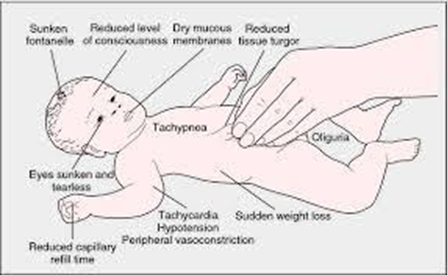A nurse is caring for a 6-month-old infant who has gastroenteritis. Which of the following findings should the nurse identify as a manifestation of severe dehydration?
Capillary refill time 3 seconds
Sunken anterior fontanel
Weight loss of 5%
Produces tears when crying
The Correct Answer is B
Rationale:
A. Capillary refill time of 3 seconds is within the normal range (less than 3 seconds) and does not indicate severe dehydration.
B. A sunken anterior fontanel is a significant sign of dehydration in infants and suggests severe dehydration.

C. While a weight loss of 5% can indicate dehydration, it may not necessarily represent severe dehydration. The extent of dehydration is better assessed by clinical signs such as fontanel status, skin turgor, and mucous membrane moisture.
D. Producing tears when crying is a reassuring sign and suggests adequate hydration, so it does not indicate severe dehydration.
Nursing Test Bank
Naxlex Comprehensive Predictor Exams
Related Questions
Correct Answer is D
Explanation
Rationale:
A. Disseminated intravascular coagulation (DIC) is associated with consumption of clotting factors, leading to prolonged clotting times, such as increased prothrombin time (PT) and activated partial thromboplastin time (aPTT), rather than decreased.
B. DIC does not typically cause an increase in hemoglobin (Hgb) levels; in fact, it may lead to anemia due to blood loss and consumption of clotting factors.
C. DIC does not typically cause an increase in red blood cell (RBC) count; if anything, it can lead to anemia due to blood loss.
D. DIC is characterized by widespread activation of coagulation, leading to consumption of platelets and decreased platelet count, which can result in bleeding tendencies.
Correct Answer is A
Explanation
Rationale:
A. This is a positive reinforcement strategy that can motivate the child to take the medication and reduce the unpleasant taste.
B. Giving milk with the medication may not be suitable for all medications, and some medications may interact with dairy products.
C. Mixing the medication with the child's favorite food is not advised because it can alter the taste and texture of the food and make the child dislike it in the future.
D. Diluting the medication with water may not be appropriate for all medications, and it could alter the effectiveness or stability of the medication.
Whether you are a student looking to ace your exams or a practicing nurse seeking to enhance your expertise , our nursing education contents will empower you with the confidence and competence to make a difference in the lives of patients and become a respected leader in the healthcare field.
Visit Naxlex, invest in your future and unlock endless possibilities with our unparalleled nursing education contents today
Report Wrong Answer on the Current Question
Do you disagree with the answer? If yes, what is your expected answer? Explain.
Kindly be descriptive with the issue you are facing.
